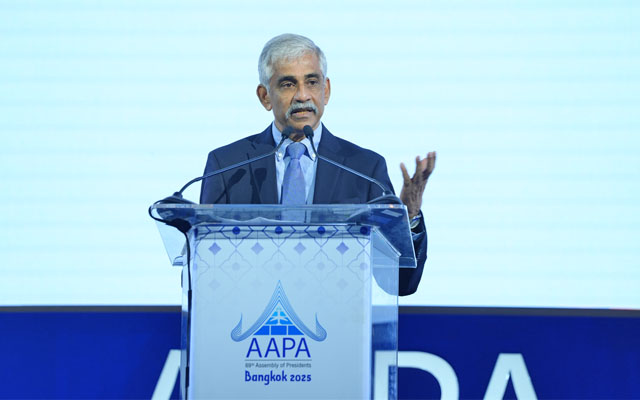Asia-Pacific airlines are heading into 2026 with a strong performance outlook, but industry leaders warn that governments must shift from short-term tourism gains to long-term industrial competitiveness to sustain growth.
At the close of the 69th Assembly of Presidents in Bangkok, the Association of Asia Pacific Airlines (AAPA) reported that carriers posted a 10 per cent rise in international passenger traffic in the first nine months of 2025, outpacing global averages and reinforcing confidence in the region’s recovery momentum.

“Asia-Pacific airlines continue to demonstrate agility in managing supply chain constraints, with capacity growth keeping pace with demand. However, Asia-Pacific economies are among the hardest hit by higher US tariffs. Further escalation of tariffs could exacerbate these bottlenecks,” noted AAPA director general Subhas Menon.
AAPA leaders also urged governments to strengthen maintenance, repair and overhaul (MRO) capacity and accelerate aviation manufacturing, warning that the region’s fragmented industrial footprint risks constraining future growth. While International Air Transport Association (IATA) data shows Asia-Pacific accounts for more than one-third of global passenger traffic, much of the world’s heavy maintenance and aviation manufacturing remains in North America and Europe, forcing airlines to route high-complexity engine work offshore.
The supply chain squeeze is worsened by ageing aircraft, rising shop-visit volumes, and a persistent labour shortage, with skilled engineers drawn to higher-paying hubs in the Middle East. Menon warned that without intervention, the region risks permanent constraints on growth.
“When we look at supply chain pressures, there are many aspects to it. But what can you do in the interim to improve the situation? For example, the region simply does not have enough MRO capacity, and only government investment and support can close that gap,” Menon stated.
Menon highlighted that some administrations still take aviation resilience for granted. He cited Asia’s prolonged pandemic border closures as an example of governments assuming airlines would cope, and warned that fragmented policymaking is emerging again, with MRO expansion, workforce development, industrial incentives, and regulatory measures pursued separately rather than strategically.
He emphasised that building a resilient supply chain requires coordination across industry, finance, trade, and manpower agencies. Signs of progress include Thailand’s coordinated approach to its one per cent SAF blend for 2026, involving the energy ministry, civil aviation authority, and fuel suppliers.
“From a long-term standpoint, if this is the largest air transport sector in the world, and the fastest growing, governments should take an interest in it and invest in the infrastructure that is needed for airlines to be able to support the growth. Yes, we do not have a common regulator, so it is a challenge. But that should not stop us from doing the right thing,” he summarised.
The Assembly adopted four resolutions, reaffirming the five per cent SAF target for 2030, urging governments to accelerate production, calling for investment incentives and harmonised regulations to expand MRO and manufacturing, endorsing stronger lithium battery safety measures, and cautioning against non–cost-related taxes that could undermine long-term growth.

















